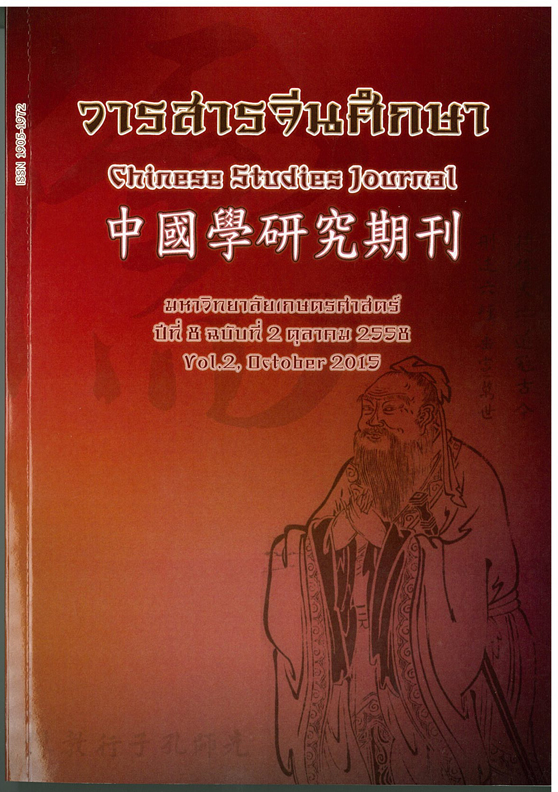การผสมผสานที่ลงตัวระหว่างงานวรรณกรรมและภาพวาดของเฟิงจื่อข่าย
Main Article Content
Abstract
เฟิงจือข่าย คือ ศิลปินด้านศิลปวรรณคดีจีนยุคใหม่ ผู้ซึ่งผสมผสานงานวรรณกรรมและงานจิตรกรรมของจีนรวมเข้าด้วยกัน โดยในขณะที่เราอ่านความเรียงของท่านนั้น นอกจากสามารถเรียนรู้ในภาพวาดของท่านแล้วในขณะชมภาพวาด เรายังสามารถทำความเข้าใจในภาพวาดนั้นได้ง่ายยิ่งขึ้น ด้วยบทประพันธ์ที่ท่านเขียนอธิบายไว้บนภาพ ซึ่งการผสมผสานระหว่างกันนั้นได้แสดงให้เห็นถึงความเชื่อมโยง ความสัมพันธ์และความเกื้อกูลระหว่างกันของวรรณกรรมและภาพวาดของจีน
วิทยานิพนธ์ฉบับนี้ทำการศึกษาบทประพันธ์ร้อยแก้วของศิลปินชาวจีน “เฟิงจือข่าย” โดยใช้ทฤษฎีวรรณคดี ทฤษฎีภาพวาดและทฤษฎีสุนทรียภาพทางศิลปะ ฯลฯ มาเป็นทฤษฎีสนับสนุนการวิจัย ศึกษาผลงานด้านศิลปะภาพวาดและงานจิตรกรรมของของเฟิงจือข่าย ซึ่งมีอิทธิพลต่อการประพันธ์ร้อยแก้วโดยตรง นอกจากนี้ได้ทำการศึกษาลักษณะ “ความสัมพันธ์” ระหว่างบทประพันธ์ร้อยแก้วและภาพวาดของเฟิงจือข่าย อย่างไรก็ตาม เนื่องจากการสื่อความหมายทางวรรณกรรมกับภาพวาดมีความแตกต่างกัน ด้วยเหตุนี้ทำให้ความงดงามของภาพวาดในบทประพันธ์ร้อยแก้วไม่สามารถถ่ายทอดออกมาได้เท่าเทียมกับภาพวาดทั่วไป วิทยานิพนธ์ฉบับนี้จึงใช้มุมมองการด้านการเปรียบเทียบมาใช้อธิบายความสัมพันธ์ระหว่างบทประพันธ์ร้อยแก้วและงานด้านจิตรกรรมของเฟิงจือข่าย พร้อมกับทำการวิเคราะห์การเกิด “ความสัมพันธ์” “ความเชื่อมโยง” และ “ความเกื้อกูล”ระหว่างบทประพันธ์กับภาพวาด สุดท้าย ทำการวิเคราะห์ความสัมพันธ์และความแตกต่างทางความงดงามของภาพวาดในวรรณกรรมกับความงดงามของภาพวาดทั่วไป จากการศึกษาวิจัยทำให้เรามีความเข้าใจในความงดงามของศิลปะทั้งสองประเภทได้เป็นอย่างดี ทั้งยังเป็นการเสนอทฤษฎีที่ใช้ในการอ้างอิงและอธิบายความงามของภาพวาดในบทประพันธ์ของเฟิงจือข่ายอีกด้วย
A Perfect Combination—— Comments on Feng zikai’s essays and pictures
Tan Zhengrong, Chinese Department, Faculty of Humanities, Naresuan University
Feng Zikai was an artist who did an excellent job of combining literature and cartoons in his works, which are rarely seen in modern art histories of China. When reading his works, the cartoons explained his essays, and the essays served as references for the cartoons. This is what was called the “acculturation of paintings and literature,” “intercommunication between paintings and literature,” and “compensation of paintings and literature.”
The aim of this study is to explore the aesthetics of the paintings in Feng Zikai’s essays. In this study, theories of literature, painting, aesthetics and so on are used to explore how Feng Zikai was trained to be a painter and how exactly his paintings influenced his essays. From this point, we further discuss the intertexuality between essays and paintings in his works. However, the aesthetics presented in his essays are not as intuitive as it is in paintings since the media of literature and paintings are different. This study first explores the motivations and purposes that promoted Feng Zikai to insist on working in different fields in an interdisciplinary approach. Second, by analyzing how the essays and cartoons are “acculturated,” how they “intercommunicate,” and how they “compensate,” for the shortcomings of the other, the aesthetics in paintings and literature can be distinguished. This study not only helps us to understand the essence of two kinds of aesthetics, paintings and literature, but also interprets the aesthetics in Fen Zikai’s essays.
散文与漫画的完美结合——论丰子恺的文与画
谭政荣,泰国纳烈宣大学人文学院东语系中文专业
丰子恺是中国现代文艺史上把文学和绘画这对姊妹成功结合的为数不多的艺术家。我们在读他散文的时候,往往可以参照他的漫画,而在欣赏他漫画的时候,也有他的散文可资解读,使其散文和漫画创作总体呈现出“文画互渗”、“文画互读”、“文画互补”的特征。
本论文将以丰子恺的散文为主体研究对象,在文学理论、绘画理论和艺术审美理论学等为理论支撑下,探究丰子恺在绘画艺术方面的修为以及所呈现出来的绘画作品对其散文创作造成的实质影响,并从中探究丰子恺的散文与漫画说呈现出的交融互通的总体特征。然而,由于文学与绘画的媒介不同,所以散文作品中所表现出来的绘画美并不像纯绘画中那样直观。本论文将从跨学科比较研究的角度来阐释丰子恺坚持散文和漫画等多领域兼修的动机和目的, 并分析其散文与漫画产生“互读”“互渗”“互补”的因缘, 最终剖析绘画的美和文学作品中绘画美的本质区别与联系,进而加深我们对两种艺术不同美质的把握,为解读丰子恺散文作品的绘画美提供理论参考。
Article Details
ผลงานทางวิชาการที่ลงตีพิมพ์ในวารสารจีนศึกษา มหาวิทยาลัยเกษตรศาสตร์ เป็นลิขสิทธิ์ของผู้เขียนหรือผู้แปลผลงานนั้น หากนำลงในวารสารจีนศึกษาเป็นครั้งแรก เจ้าของผลงานสามารถนำไปตีพิมพ์ซ้ำในวารสารหรือหนังสืออื่นได้โดยมิต้องแจ้งให้ทราบล่วงหน้า แต่หากผลงานที่ได้รับพิจารณานำลงในวารสารจีนศึกษา เป็นผลงานที่เคยตีพิมพ์ที่อื่นมาก่อนเจ้าของผลงานต้องจัดการเรื่องปัญหาลิขสิทธิ์กับแหล่งพิมพ์แรกเอง หากเกิดปัญหาทางกฎหมาย ถือว่าไม่อยู่ในความรับผิดชอบของวารสารจีนศึกษา มหาวิทยาลัยเกษตรศาสตร์ ทั้งนี้ ความคิดเห็นต่างๆ ในบทความเป็นความคิดเห็นส่วนตัวของผู้เขียน ไม่เกี่ยวกับกองบรรณาธิการวารสารจีนศึกษา มหาวิทยาลัยเกษตรศาสตร์


